

Tasks. Pi Day: History of Pi. Pi has been known for almost 4000 years—but even if we calculated the number of seconds in those 4000 years and calculated pi to that number of places, we would still only be approximating its actual value.
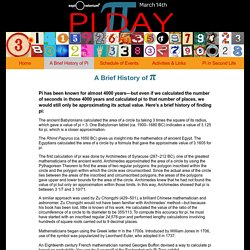
Here’s a brief history of finding pi: The ancient Babylonians calculated the area of a circle by taking 3 times the square of its radius, which gave a value of pi = 3. One Babylonian tablet (ca. 1900–1680 BC) indicates a value of 3.125 for pi, which is a closer approximation. The Rhind Papyrus (ca.1650 BC) gives us insight into the mathematics of ancient Egypt. The Egyptians calculated the area of a circle by a formula that gave the approximate value of 3.1605 for pi. The first calculation of pi was done by Archimedes of Syracuse (287–212 BC), one of the greatest mathematicians of the ancient world. A similar approach was used by Zu Chongzhi (429–501), a brilliant Chinese mathematician and astronomer. Mathematicians began using the Greek letter π in the 1700s. Greeting_card.pdf. Geometry Playground: Activities: Tiny pants photo challenge. Try This Draw some pants or find a pants photo in a magazine.

Glue the pants to the card stock. Cut them out. Hints: Use a small aperture, turn off the flash, and if possible, shoot your photos outside, in bright sunlight. You can also make tiny shirts, or other things to wear. Tape them to the end of a stick. What’s so funny about tiny pants? The illusion that the tiny pants “fit” is based on the way you perceive size and distance. With both eyes open, you can perceive depth—so if an object is farther away, your brain tells you that it’s larger. When you close one eye, you impair your depth perception, so your brain can’t easily tell that your friend is much bigger than the pants. How far away should your friend stand? Blue Lightning. Amaze and delight others as you multiply, divide, and square at lightning fast speed.
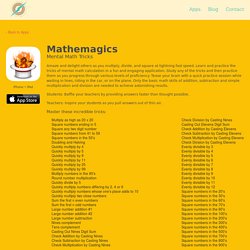
Learn and practice the tricks of mental math calculation in a fun and engaging application. Study any of the tricks and then practice them as you progress through various levels of proficiency. Tease your brain with a quick practice session while waiting in lines, riding in the car, or on the plane. Only the basic math skills of addition, subtraction and simple multiplication and division are needed to achieve astonishing results. Students: Baffle your teachers by providing answers faster than thought possible. Online Math League. Build Your Own Mobile.
Each TeachEngineering lesson or activity is correlated to one or more K-12 science, technology, engineering or math (STEM) educational standards.
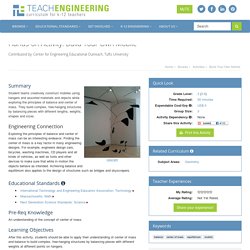
All 100,000+ K-12 STEM standards covered in TeachEngineering are collected, maintained and packaged by the Achievement Standard Network (ASN), a project of JES & Co. (www.jesandco.org). In the ASN, standards are hierarchically structured: first by source; e.g., by state; within source by type; e.g., science or mathematics; within type by subtype, then by grade, etc. Click on the standard groupings to explore this hierarchy as it applies to this document. Learning Objectives After this activity, students should be able to apply their understanding of center of mass and balance to build complex, free-hanging structures by balancing pieces with different weights at different points on hangers. Introduction/Motivation Think of all the times you use your body to try to balance.
Every object on our planet has what we call a center of mass. Boxed In and Wrapped Up - Lesson. Summary Students review how to determine the surface area and volume of a rectangular prism, that all dimensions are equal in cubes so the volume of cubes are the length of any side raised to the third power, or cubed.

This prepares them for two associated activities. First, students find the volumes and surface areas of rectangular boxes such as cereal boxes and then figure out how to convert their boxes into a new, cubical boxes having the same volume as the original. As they construct the new, cube-shaped boxes from the original box material, students discover that the cubical box has less surface area than the original, and thus, a cube is a more efficient way to package items.
Students consider why consumer goods are generally not packaged in cube-shaped boxes, even though this would require fewer materials and ultimately, less waste. Engineering Connection Students learn to think like packaging engineers while considering ways in which consumer goods are boxed. Pre-Req Knowledge. Ball Bounce Experiment. Summary Many of today's popular sports are based around the use of balls, yet none of the balls are completely alike.
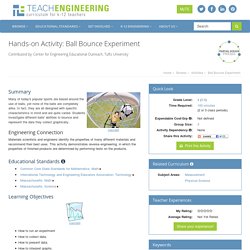
In fact, they are all designed with specific characteristics in mind and are quite varied. Students investigate different balls' abilities to bounce and represent the data they collect graphically. Engineering Connection Materials scientists and engineers identify the properties of many different materials and recommend their best uses. Educational Standards Each TeachEngineering lesson or activity is correlated to one or more K-12 science, technology, engineering or math (STEM) educational standards. All 100,000+ K-12 STEM standards covered in TeachEngineering are collected, maintained and packaged by the Achievement Standard Network (ASN), a project of JES & Co. Assessing the Situation. Summary Finding themselves in the middle of the Amazon rainforest after a plane crash, students use map scales, keys, and longitude and latitude coordinates to figure out where they are.
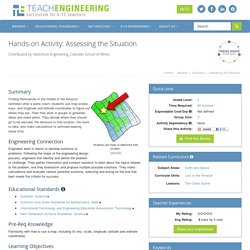
Then they work in groups to generate ideas and make plans. They decide where they should go to be rescued, the distance to that location, the route to take, and make calculations to estimate walking travel time. Engineering Connection Engineers work in teams to develop solutions to problems. Educational Standards Each TeachEngineering lesson or activity is correlated to one or more K-12 science, technology, engineering or math (STEM) educational standards. All 100,000+ K-12 STEM standards covered in TeachEngineering are collected, maintained and packaged by the Achievement Standard Network (ASN), a project of JES & Co.